RARE Medal Grouping from member of the Connaught Rangers, WWI and WWII medals
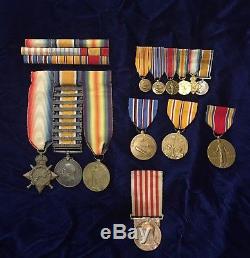
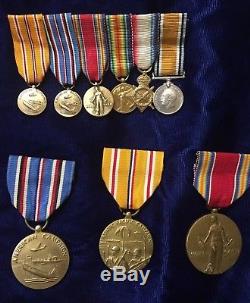
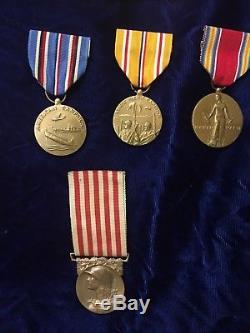
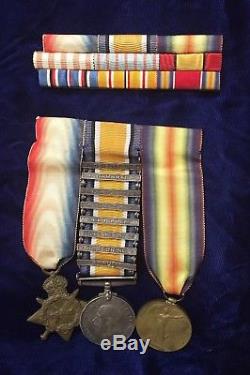
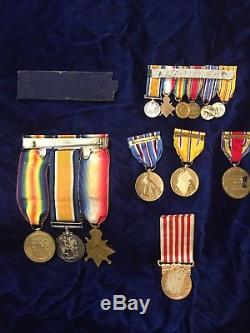
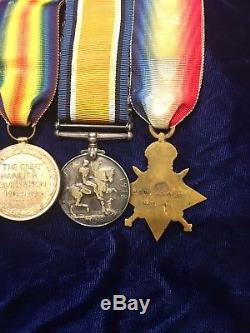
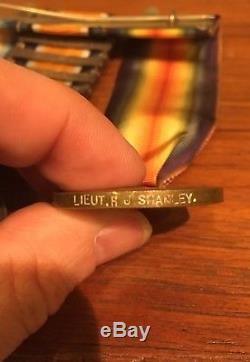
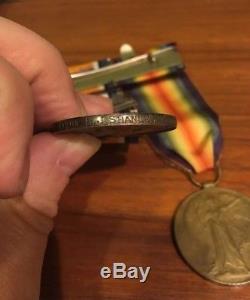
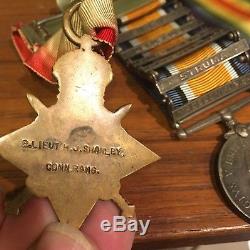
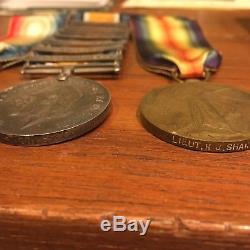
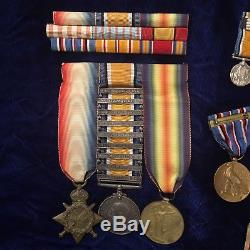
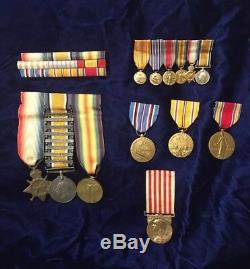

Nice grouping of WWI & WWII medals which are stamped with the name Second Lieutenant H. Shanley who was a member of the Connaught Rangers. Very rare as the soldier went on to serve in WWII and this lot includes medals from both conflicts. Thank you for your keen insights and information.
I had not noticed the engraving on the three British medals, so attach an image of each here showing the engraving of Shanleys name. Several keen observers noted that on the middle medal, the engraving has Shanley's name and the abbreviation Comm Rang. I do not know the reason, but several knowledgeable parties indicated that they have seen this on similar pieces and the imprint could indicate commonwealth. The first medal is stamped Conn Rang. A worthy piece of research. The starting price is much lower than the final value on the previous sale, so let this be your opportunity to get the items at a bargain price, or as a second chance for those interested parties.Beautiful collection of medal (regular size and miniature) from Second Lieutenant H. The collection includes the three British WWI campaign medals The 1914 Star or 1914-15 Star, British War Medal and Victory Medal. Shanleys American and French awards from WWII. These include the World War Two victory medal, Asiatic Pasific Campaign Medal, American Campaign. The French award is from WWI; Commemorative Medal of the War of 1914 - 1918 The three English medals are affectionately called Pip, Squeak and Wilfred The 1914 Star or 1914-15 Star, British War Medal and Victory Medal respectively.
These medals were primarily awarded to the Old Contemptibles B. And by convention all three medals are worn together and in the same order from left to right when viewed from the front. The set of three medals or at least the British War Medal and the Victory Medal are the most likely medals to be found among family heirlooms. When the WW1 medals were issued in the 1920's it coincided with a popular comic strip published by the Daily Mirror newspaper. It was written by Bertram J. Lamb (Uncle Dick), and drawn by the cartoonist Austin Bowen Payne A. Pip was the dog, Squeak the penguin and Wilfred the young rabbit. It is believed that A. Payne's batman during the war had been nicknamed Pip-squeak and this is where the idea for the names of the dog and penguin came from. For some reason the three names of the characters became associated with the three campaign medals being issued at that time to many thousands of returning servicemen, and they stuck. Medals have traces of adhesive on the verso from a mounting. Truly fantastic piece of history. A must for the SERIOUS Collector / Scholar of WWI and WWII history. Brief History of Connaught Rangers in WWI. The Connaught Rangers ("The Devil's Own") were an Irish line infantry regiment of the British Army formed by the amalgamation of the 88th Regiment of Foot (Connaught Rangers) (which formed the 1st Battalion) and the 94th Regiment of Foot (which formed the 2nd Battalion) in July 1881. Between the time of its formation and Irish independence, it was one of eight Irish regiments raised largely in Ireland. Its home depot was in Galway. It was disbanded following the establishment of the independent Irish Free State in 1922, along with the other five regiments that had their traditional recruiting grounds in the counties of the new state. The regiment was formed by the amalgamation of the 88th Regiment of Foot (Connaught Rangers) (which formed the 1st Battalion) and the 94th Regiment of Foot (which formed the 2nd Battalion) in July 1881. The amalgamation of the two regiments into one with the title The Connaught Rangers, was part of the United Kingdom government's reorganization of the British Army under the Childers Reforms, a continuation of the Cardwell Reforms implemented in 1879 "The Connaught Rangers" by Richard Simkin (18401926) It was one of eight Irish regiments raised largely in Ireland, with its home depot at Renmore Barracks in Galway. The regiment recruited mainly in the province of Connacht. Militarily, the whole of Ireland was administered as a separate command within the United Kingdom with Command Headquarters at Parkgate (Phoenix Park) in Dublin, directly under the War Office in London. The 88th were based in Bengal, British India, when they were amalgamated into the new regiment.The 2nd Battalion deployed to the Sudan in 1896 for the Dongola Expeditionary Force under the command of Lord Kitchener as part of the reconquest of the Sudan before moving to India in 1897. Second Boer War The 1st Battalion deployed to South Africa as part of 5th (Irish) Brigade, commanded by Major-General Fitzroy Hart, and saw action at the Battle of Colenso in December 1899, part of the attempt to relieve the town of Ladysmith, besieged by Boer forces. The Brigade suffered heavily during their participation in the battle, the Boers inflicting heavy casualties: the regiment had 24 men killed and 105 officers and men wounded. The Rangers fought at Spion Kop in January 1900 and the Tugela Heights in February 1900 during further attempts by General Sir Redvers Buller to relieve the besieged town of Ladysmith.
In late February the siege of Ladysmith finally came to an end after it was relieved by British forces. In 1908, the Volunteers and Militia were reorganized nationally, with the former becoming the Territorial Force and the latter the Special Reserve; the regiment now had three Reserve but no Territorial battalions.First World War The 1st Battalion, which was commanded by Lieutenant-Colonel Hurdis Ravenshaw and had been stationed in Ferozepore, India, landed as part of the 7th (Ferozepore) Brigade in the 3rd (Lahore) Division at Marseille in September 1914 for service on the Western Front. The 2nd Battalion landed at Boulogne-sur-Mer as part of the 5th Brigade in the 2nd Division with the British Expeditionary Force in August 1914 for service on the Western Front. Its marching song It's a Long Way to Tipperary became famous.
By October, the battalion was involved in the fighting around Ypres. On one occasion Private Grogan rushed seven Germans who had occupied a section of trench. He killed all of them. It cost him a cut forehead and four teeth. Following severe losses in the battles of 1914, the 2nd Battalion was disbanded, with survivors transferring into the 1st Battalion. In turn, the 1st Battalion was redeployed to the Middle East in 1916, where it fought primarily in modern day Iraq as part of the British Tigris Corps. The 3rd (Reserve) Battalion was based in Galway upon the declaration of war and would remain in Ireland until November 1917 when it moved to England.The 4th (Extra Reserve) Battalion had been based in Boyle in August and would remain there until November 1917 when it relocated to Scotland: it was absorbed into the 3rd Battalion in May 1918. New Armies The 5th (Service) Battalion, which was formed in Dublin in August 1914, landed at Anzac Cove in Gallipoli in August 1915 as part of the 29th Brigade in the 10th (Irish) Division but moved to Salonika in September 1915 for service on the Macedonian Front and then transferred to Egypt for service in Palestine in September 1917 before landing at Marseilles in June 1918 for service on the Western Front. The 6th (Service) Battalion, which was formed in County Cork in September 1914, landed at Le Havre as part of the 47th Brigade in the 16th (Irish) Division in December 1915 for service on the Western Front. In just over a week's fighting in the Battle of the Somme in September 1916, the 6th Battalion lost 23 officers and 407 other ranks.
On 21 March 1918, the same Battalion was "practically annihilated" during the German Spring Offensive breakthrough. In one week the battalion lost "22 officers and 618 other ranks". As a result of these heavy losses, the survivors were transferred into the 2nd Battalion, the Leinster Regiment.1916 Easter Rising In April 1916, during World War 1, in what became known as the Easter Rising, Irish Republican revolutionary forces in Ireland launched an armed insurrection against the authority of the government of the United Kingdom, with the declared aim of establishing an Irish Republic wholly independent in its sovereign governance from the United Kingdom. In response, the Connaught Rangers and other British Army units were deployed to fight against the paramilitary revolutionary forces of the "Irish Volunteers".
None of the Connaught Rangers were killed in action but one was wounded. A 584-man strong column from the 3rd Battalion Connaught Rangers, commanded by Lieutenant Colonel A J Digan DSO, marched on Enniscorthy to fight the revolutionaries who had taken over the town, however on arrival decided not to attack the revolutionaries' positions within the town to avoid turning Enniscorthy into a battlefield. In the days after the insurrection began the Connaughts patrolled the countryside seeking contact with any revolutionary war parties that cared to show themselves, in the process capturing hundreds of prisoners of war and seizing their weapons stocks. A 250 strong force of the Connaughts, under the commanded of Major H. Hutchinson, marched to Ferns on 4 May 1916, and then on to Gorey the next day.
A party of 31 Connaught Rangers led by Lieutenant L. Badham searched houses in Kinsale on 4 May 1916, and the next day captured a large number of revolutionaries and their weapons. The Connaught Rangers' Column searched houses in New Ross on 9 May 1916 and then at Waterford the next day. The Connaught Rangers Column reached Clonmel on 16 May 1916, searching further residences in the town and capturing another large number of revolutionaries and their weapon-stocks. Another Column of Connaught Rangers, 422 men strong, led by Major O. Lloyd, searched houses in Bandon from 6 May to 11 May 1916, capturing further numbers of revolutionaries and weapons. The Column proceeded on to Clonakilty on 11 May and searched the district there also, capturing more revolutionaries and their equipment. This Column marched to Skibbereen on 16 May, and entering the town and fanning out through the surrounding area, succeeded in rounding up more revolutionaries with their arms. A number of Connaught Rangers who were in Dublin at the time of the Easter Rising had volunteered for temporary secondment to other units of the British Army such as the Royal Irish Fusiliers and Royal Dublin Fusiliers specifically to take part in the capital city's defense against the revolution. Sergeant John Joseph Barror of the Connaught Rangers killed two revolutionaries in the fighting in Dublin.Postwar Following demobilization the Connaught Rangers was reduced to its peacetime establishment of two regular battalions. With the outbreak of the Irish War of Independence in 1919 both were stationed outside Ireland (the 2nd Battalion in Dover and the 1st in India). This was part of a general policy aimed at minimizing the pressures of divided loyalties, by relocating serving Irish regiments during "the troubles".
Mutiny in India, 1920 On 28 June 1920, five men from C Company of the 1st Battalion, based at Wellington Barracks, Jalandhar in the Punjab, decided to protest against the effects of martial law in Ireland by refusing to obey orders. Poor accommodation conditions in the Wellington Barracks appear to have provided an additional, localized, cause of unrest. The C Company protestors were soon joined by other Rangers (who included at least one Englishman, John Miranda, from Liverpool). The dissidents were led by Private James Daly (whose brother William also took part in the protest at Jalandhar).
The protest now spread to the Connaught Ranger companies stationed at Jutogh and Solan. Initially the protests were peaceful with the soldiers affected putting on Sinn Féin rosettes and singing Irish nationalist songs.
However on the evening of 1 July a party of about thirty men, carrying bayonets and led by James Daly, attempted to seize their company's rifles [26] stored in the armory at Solon. The troops guarding the magazine opened fire and two were killed: Private Patrick Smythe who was with Daly's party and Private Peter Sears. Private Sears had not been involved in the attack on the magazine but was returning to his quarters when struck by a stray bullet. Within days, both garrisons were occupied by other British troops; Daly and his followers surrendered and were taken prisoner.
Eighty-eight mutineers were court-martialed: seventy-seven were sentenced to imprisonment and ten were acquitted. The 21-year-old Daly was shot by a firing squad in Dagshai Prison on 2 November 1920: he was the last member of the British Armed Forces to be executed for mutiny. Private Sears and Private Smyth were buried at Solan, while Daly and Miranda (who later died in prison) were buried at the Dagshai graveyard.Among those who received life in prison were Val Delaney, J. Buckley, and Eugene Egan (all from Claremorris), Jack Scanlon from Sligo town and Charlie Kerrigan from Glencar, and Martin Conlon (a half-brother to the eight brothers from Sligo town who fought in the First World War, in which four were killed in action). [26] In 1936, the Free State's Fianna Fáil government awarded pensions to those whose British Army pensions were forfeited by conviction for their part in the mutiny. The bodies of Sears, Smith, and Daly were repatriated from India to Ireland for reburial in 1970.
Disbandment Due to substantial defense cuts and the establishment of the Irish Free State in 1922, it was decided that the six former Southern Ireland regiments would be disbanded, including the Connaught Rangers. On 12 June, five regimental colors were laid up in a ceremony at St George's Hall, Windsor Castle in the presence of HM King George V. The six regiments were then all disbanded on 31 July 1922. With the simultaneous outbreak of the Irish Civil War conflict some thousands of their ex-servicemen and officers contributed to expanding the Free State government's newly formed National Army.
They brought considerable combat experience with them and by May 1923 comprised 50 per cent of its 53,000 soldiers and 20 per cent of its officers. Memorials In 1966 a stained glass memorial window to the Connaught Rangers was included in the new Galway Cathedral, which renders honor to a regiment so long associated with that part of Ireland. There are various memorials to the regiment and its soldiers in St.
Nicholas' Collegiate Church in Galway. Battle honors The regiment was awarded the following battle honors: From the 88th Regiment of Foot: Egypt, Talavera, Busaco, Fuentes d'Onoro, Ciudad Rodrigo, Badajoz, Salamanca, Vittoria, Nivelle, Orthes, Toulouse, Peninsula, Alma, Inkerman, Sevastopol, Central India From the 94th Regiment of Foot: Seringapatam, Ciudad Rodrigo, Badajoz, Salamanca, Vittoria, Nivelle, Orthes, Toulouse, Peninsula, Pyrenees, South Africa 1877-78-79 Second Boer War: Relief of Ladysmith, South Africa 18991902 The Great War: Mons, Retreat from Mons, Marne 1914, Aisne 1914, Messines 1914'17, Armentières 1914, Ypres 1914'15'17, Langemarck 1914'17, Gheluvelt, Nonne Bosschen, Festubert 1914, Givenchy 1914, Neuve Chapelle, St. Julien, Aubers, Somme, 1916'18, Guillemont, Ginchy, St. Quentin, Bapaume 1918, Rosières, Hindenburg Line, Cambrai 1918, Selle, France and Flanders 19141918, Kosturino, Struma, Macedonia 191517, Suvla, Sari Bair, Scimitar Hill, Gallipoli 1915, Gaza, Jerusalem, Tell'Asur, Megiddo, Sharon, Palestine 191718, Tigris 1916, Kut al Amara 1917, Baghdad, Mespotamia 191618. The item "RARE Medal Grouping from member of the Connaught Rangers, WWI and WWII medals" is in sale since Sunday, December 30, 2018.
This item is in the category "Collectibles\Militaria\WW I (1914-18)\Original Period Items\Great Britain\Medals, Pins & Ribbons". The seller is "pa-history-coll" and is located in New York, New York. This item can be shipped to North, South, or Latin America, all countries in Europe, Australia.

